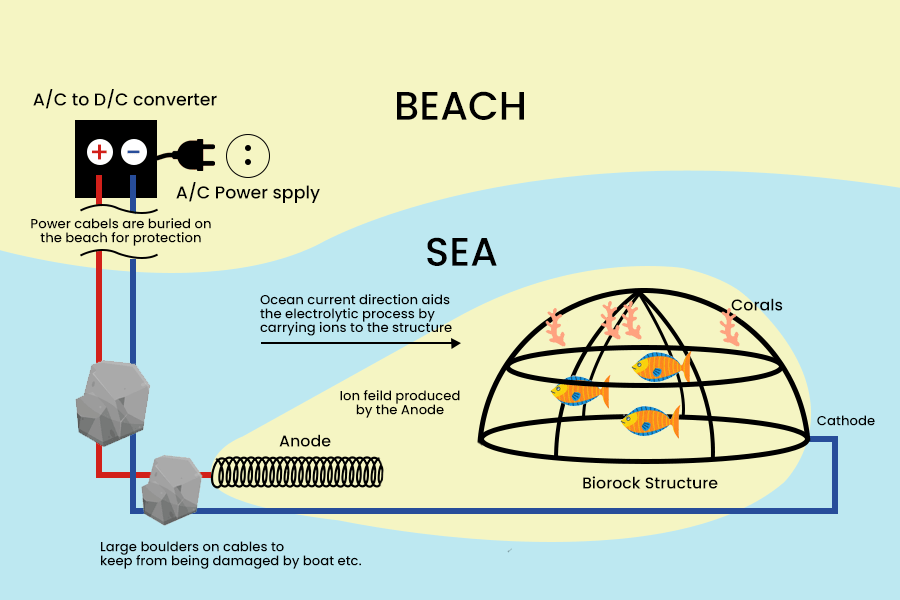How It Works
Living Breakwater Technologies
Living breakwater technologies are innovative coastal protection measures that combine traditional engineering solutions with ecological approaches to enhance the resilience of coastal communities and ecosystems against the impacts of climate change and coastal erosion.
Living Breakwater: Saving Island Ocean Ecosystems

Introduction
Coastal areas around the world are experiencing significant environmental and socioeconomic changes due to climate change and sea-level rise. One of the most pressing issues facing these communities is the increasing risk of coastal erosion and storm surge flooding, which can cause significant damage to infrastructure, property, and human life. Living breakwater technology is an innovative solution that combines traditional engineering approaches with ecological solutions to address these challenges. This paper provides an overview of living breakwater technology, its benefits, and examples of its implementation around the world.
What is Living Breakwater Technology?
Living breakwater technology is a type of coastal protection measure that integrates ecological and engineering approaches to enhance the resilience of coastal communities and ecosystems against the impacts of climate change and coastal erosion. The technology involves the deployment of artificial reefs or breakwaters made of natural materials such as rocks, shells, or concrete, which are designed to reduce the intensity of waves and protect the shoreline from erosion. In addition to these structural measures, living breakwater technology also incorporates the establishment of mangrove forests, seagrass beds, and other coastal vegetation to provide additional wave attenuation, shoreline stabilization, and habitat enhancement benefits.
Benefits of Living Breakwater Technology
Living breakwater technology offers several benefits for coastal communities and ecosystems. First, it provides effective protection against coastal erosion and storm surge flooding, reducing the risk of damage to infrastructure, property, and human life. Second, it enhances the resilience of coastal ecosystems by providing habitat for marine organisms, improving water quality, and supporting the growth of coastal vegetation. Third, living breakwater technology can help mitigate the effects of climate change by sequestering carbon dioxide by establishing coastal vegetation and reducing the need for energy-intensive coastal protection measures.
Examples of Living Breakwater Technology
Living breakwater technology has been implemented in a number of coastal areas around the world, including in the United States, where it has been used to protect vulnerable communities in places like Staten Island and New York. The “Living Breakwaters” project, launched in response to the devastation caused by Hurricane Sandy in 2012, involved deploying a series of artificial reefs and breakwaters made of natural materials, combined with the establishment of oyster beds and other coastal vegetation. The project has successfully reduced wave energy and erosion while providing a habitat for marine organisms and improving water quality.
Living breakwater technology has also been deployed in Southeast Asia, where it has been used to protect coastal villages in Indonesia and the Philippines. The “Building Resilience to Climate Change Through Coastal Protection and Management” project, which the Asian Development Bank funded, involved the deployment of artificial reefs made of concrete blocks and the establishment of mangrove forests and seagrass beds. The project has been successful in reducing wave energy and erosion while also providing a habitat for marine organisms and supporting the livelihoods of local communities.
Future Excitement
Living breakwater technology offers a promising solution to the increasing risk of coastal erosion and storm surge flooding facing coastal communities around the world. By combining ecological and engineering approaches, living breakwater technology provides effective protection against coastal erosion and storm surge flooding, enhances the resilience of coastal ecosystems, and helps mitigate climate change’s effects. The success of living breakwater technology in projects such as the “Living Breakwaters” project in Staten Island and the “Building Resilience to Climate Change Through Coastal Protection and Management” project in Southeast Asia demonstrates its potential as a sustainable and effective solution to the challenges facing coastal communities today.
References:
– National Oceanic and Atmospheric Administration. (2021). Living Breakwaters. Retrieved from https://coast.noaa.gov/states/fast-facts/living-breakwaters.html
– TNC. (2021). Living Breakwaters. Retrieved from https://www.nature.org/en-us/about-us/where-we-work/un
The Island Promise
The concept of using natural materials to protect coastlines has been around for centuries. In a paper published in 1979 by Japanese researchers Kiyoshi Tanaka and Yoshio Horiguchi, titled “Artificial Reefs as Breakwaters,” Tanaka and Horiguchi describe the results of experiments they conducted to study the effectiveness of artificial reefs in reducing wave energy and preventing coastal erosion. They concluded that artificial reefs could be an effective and cost-efficient alternative to traditional coastal protection measures such as seawalls and groynes, and that they could also provide habitat for marine organisms.
Haryo Dwito Armono (2004)
Artificial Reefs as Shoreline Protection Structures
Most of the earlier studies on artificial reefs have been carried out by biologists and marine scientists rather than coastal engineers.
Baker, Scott, et al. (2022)
Design and Physical Model Studies of Innovative Living Breakwaters
This paper describes two separate but closely related physical models conducted to support the detailed design of the Living Breakwaters project located in Raritan Bay, New York.

FAQ
What are Living Breakwater Technologies?
Living breakwater technologies typically involve the deployment of artificial reefs or breakwaters made of natural materials such as rocks, shells, or concrete, which are designed to reduce the intensity of waves and protect the shoreline from erosion. In addition to these structural measures, living breakwater technologies also incorporate the establishment of mangrove forests, seagrass beds, and other coastal vegetation to provide additional wave attenuation, shoreline stabilization, and habitat enhancement benefits.
How do living breakwater technologies work?
Living breakwater technologies work by combining ecological and engineering approaches to enhance the resilience of coastal communities and ecosystems against the impacts of coastal erosion and climate change.
The technology involves the deployment of artificial reefs or breakwaters made of natural materials such as rocks, shells, or concrete. These reefs and breakwaters are strategically placed offshore to reduce the intensity of waves before they reach the shoreline. As waves approach the breakwaters, they are forced to slow down, which reduces their energy and prevents them from causing damage to the shoreline.
In addition to these structural measures, living breakwater technologies also incorporate the establishment of mangrove forests, seagrass beds, and other coastal vegetation. These natural elements provide additional wave attenuation, shoreline stabilization, and habitat enhancement benefits. Mangrove forests, for example, have extensive root systems that help to anchor sediments and provide additional wave attenuation. Seagrass beds help to stabilize sediments and provide habitat for a variety of marine organisms.
Living breakwaters also have the potential to mitigate the effects of climate change by sequestering carbon dioxide through the establishment of coastal vegetation. They can also reduce the need for energy-intensive coastal protection measures such as seawalls, which can be detrimental to coastal ecosystems.
Overall, living breakwater technologies work by combining traditional engineering solutions with ecological approaches to provide effective coastal protection while enhancing the resilience of coastal ecosystems.
What are the advantages of living breakwater technologies?
Living breakwater technologies offer several advantages over traditional coastal protection measures, including:
1. Enhanced Resilience: Living breakwaters help to enhance the resilience of coastal communities and ecosystems against the impacts of climate change and coastal erosion. By combining ecological and engineering approaches, living breakwaters provide effective protection against coastal erosion and storm surge flooding while also promoting the growth of coastal vegetation and the restoration of habitat for marine organisms.
2. Reduced Costs: Living breakwaters are often less expensive to construct and maintain than traditional coastal protection measures such as seawalls or breakwaters made of concrete or steel. Additionally, they require less energy to construct, which can help to reduce carbon emissions and mitigate the effects of climate change.
3. Improved Water Quality: Living breakwaters can help to improve water quality by promoting the growth of coastal vegetation and reducing sediment runoff. This can have significant benefits for coastal ecosystems, as well as for human health and recreational activities.
4. Increased Biodiversity: Living breakwaters provide habitat for a wide range of marine organisms, including fish, shellfish, and other invertebrates. This can help to promote biodiversity and support the growth of commercial and recreational fisheries.
5. Sustainable Solution: Living breakwaters are a sustainable solution to coastal erosion and storm surge flooding, as they work with natural processes to provide effective protection. They are also adaptable to changing environmental conditions, which makes them a reliable solution for coastal communities facing the challenges of climate change.
In summary, living breakwater technologies offer a range of advantages over traditional coastal protection measures. They are cost-effective, promote biodiversity and water quality, and offer a sustainable solution to the challenges of climate change and coastal erosion.
How old are living breakwater technologies?
Living breakwater technologies are a relatively new approach to coastal protection that has gained increasing attention in recent years. While the concept of using natural materials and ecological approaches to protect coastlines is not new, the application of living breakwater technologies as a formal engineering approach is a relatively recent development.
One of the earliest examples of living breakwater technologies dates back to the 1970s, when researchers in Japan began exploring the use of artificial reefs to protect coastlines from the effects of coastal erosion and storm surge flooding. Since then, the technology has evolved and been refined to incorporate a wider range of ecological and engineering approaches, including the use of mangroves, seagrasses, and other coastal vegetation.
In the United States, the first large-scale living breakwater project was constructed in Staten Island, New York in 2016. The project, known as the “Living Breakwaters” project, involved the construction of a series of artificial reefs and the establishment of oyster beds and other coastal vegetation to provide protection against coastal erosion and storm surge flooding.
Overall, while the concept of living breakwater technologies is not new, the formal application of the technology as an engineering approach to coastal protection is a relatively recent development that has gained increasing attention in recent years.
Are there different types of living breakwater technologies?
Yes, there are several types of living breakwater technologies that have been developed and implemented around the world. These include:
1. Artificial Reefs: Artificial reefs are a common type of living breakwater technology that involves the placement of structures made of natural materials such as rocks, concrete, or shells in offshore waters. These structures can help to reduce the intensity of waves before they reach the shoreline and promote the growth of marine organisms.
2. Mangrove Forests: Mangrove forests are another type of living breakwater technology that have been used to protect coastlines in many parts of the world. Mangroves have extensive root systems that help to anchor sediments and provide additional wave attenuation. They also provide habitat for a wide range of marine organisms.
3. Seagrass Beds: Seagrass beds are another type of living breakwater technology that can help to reduce the intensity of waves before they reach the shoreline. They also help to stabilize sediments and provide habitat for a variety of marine organisms.
4. Oyster Reefs: Oyster reefs are a type of living breakwater technology that have been used in some coastal areas to provide protection against erosion and storm surge flooding. Oyster reefs help to reduce the intensity of waves and provide habitat for a variety of marine organisms.
5. Coral Reefs: Coral reefs are a type of living breakwater technology that provide natural protection against coastal erosion and storm surge flooding. They also provide habitat for a wide range of marine organisms and are important for supporting the health of coastal ecosystems.
Overall, there are several different types of living breakwater technologies that can be used to protect coastlines and enhance the resilience of coastal ecosystems. The choice of technology will depend on factors such as the local environmental conditions, the severity of the coastal erosion and storm surge flooding, and the goals of the coastal protection project.


